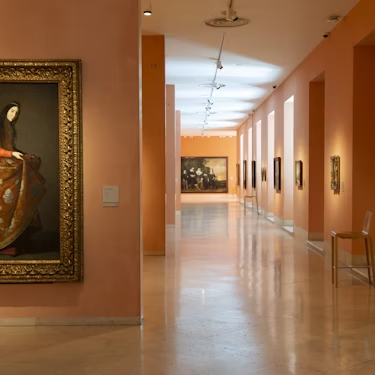More about: Madrid in 1 Day: a guidebook for getting the most out of your visit
The sheer number of monuments, palaces, museums and interesting places that Madrid has to offer means that just one day is not enough to enjoy the city in depth. Just to see the Prado Museum in peace and quiet would require a lot of time, not to mention other museums such as the Reina Sofía.
However, if you only have that time, you should try to make the most of it and leave what you can't see for a later visit. Read on and discover a route that can help you enjoy your stay and make the most of it.
- Madrid Prado Museum Tickets
- From £16
- At your own pace
- Without a guide
- Discover one of the world's top-rated art galleries.
- Direct access without queuing
- Book now
- Madrid Sightseeing Bus Tour
- From £24
- At your own pace
- Audioguide
- Visit Madrid's most emblematic sites
- Free Wifi on board
- Book now
- Madrid Royal Palace Guided Tour
- From £30
- 1h 30 min
- Expert guide
- Tour this 135,000 square metre palace
- Direct access without queues
- Book now
Start by getting to know the main works of the Prado Museum
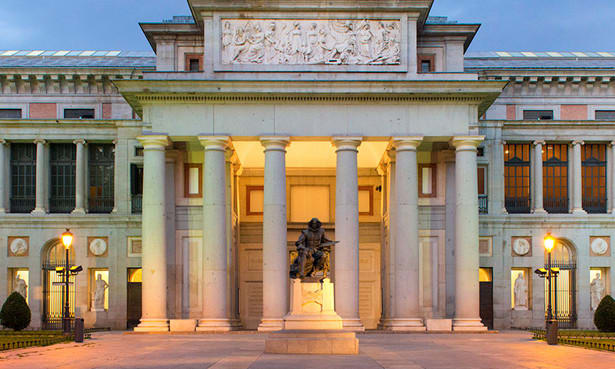
To start your visit to Madrid, there is nothing better than getting up early to be at the door of the Prado Museum. However, bear in mind that it is one of the most visited museums in the world, so I recommend that you book your tickets for the Prado Museum with direct access: in advance.
Also, in preparation for your visit, here is some information about prices and how to get there, although it's not at all complicated thanks to the Madrid metro Located in an area where you will find some of the best museums in Madrid, the Prado houses, without a doubt, the best art collection in the country. Obviously, if you only have one day it will be impossible to see it in its entirety, but you can at least try to admire its best paintings
Unfortunately, with only 24 hours it will be impossible for you to enter the other two museums on the so-called Paseo del Arte: the Reina Sofía and the Thyssen-Bornemisza. The only positive thing is that this will give you a great excuse to return to the capital at your leisure.
Discover Plaza de Cibeles

Continuing along the Paseo del Prado you will reach the Plaza de Cibeles, but not before passing by the Neptune Fountain. This small square is one of the most visited places in the city and has some elements that you should pay attention to.
- The Cibeles Fountain: it represents the Roman goddess Cybele. Built in 1782, it is one of the symbols of the city and, of course, for Real Madrid fans who celebrate their titles there. If you've been on a tour of the Santiago Bernabéu you'll no doubt have seen a photo of it. And if you haven't been and you're a Real Madrid fan, taking a tour of the Santiago Bernabéu stadium will definitely be a great plan for you.
- Palacio de Cibeles: although it is really striking from the outside, if you can spare a few minutes I recommend you go inside to see the so-called Galería de Cristal, a dome located in the inner courtyard. Admission is free and it is open from 10 am to 8 pm every day, although you can also book a tour of the Retiro and the Palacio de Cibeles in Madrid
- Banco de España: in neoclassical style, the central headquarters of the Banco de España is considered one of the best examples of Spanish architecture of the 19th century.
Guided tour or on your own?
There are many types of guided tours that will take you around the centre of Madrid. One of the advantages of going with a guide is that you won't waste any time looking for each of the attractions you want to see and you will learn more about the history thanks to the explanations you will hear. Some of the best options are the following:
- Book a bike tour of Madrid, from £34
- Book a segway tour of Madrid, from £29.
- Book a bus tour of Madrid, from £58.
- Book an electric bike tour of Madrid, from £39.
- Book a private tour of Madrid, from £91.
- Book a private tuk tuk tour of Madrid, from £40.
- Book a private bike tour in Madrid, from £34.
- Book a personalised private tour of Madrid, from £42.
If you want to go on your own, the 24-hour tour is easy and can be done on foot. Another intermediate option is to use a tourist bus. In fact, booking a seat on the Madrid sightseeing bus is one of the best ways to get to know the Spanish capital in a short time and at your own pace.
The Puerta del Sol, the country's kilometre 0
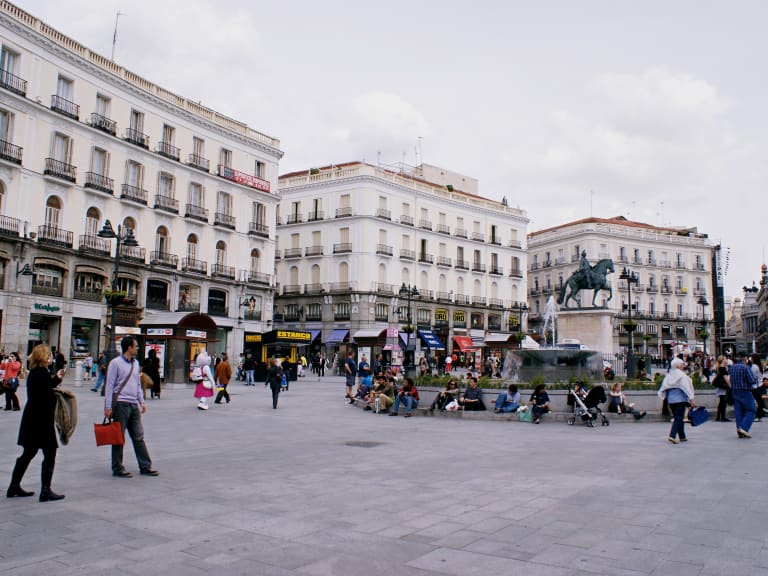
The next destination on the tour is another of the must-see places for all visitors to Madrid: Puerta del Sol. This is where the country's kilometre 0 is located, as this is where the six main roads that start from the capital begin to measure out. To commemorate this, a plaque was installed in the ground, right in front of the Presidency of the Regional Government.
This square is also home to the famous Puerta de Sol clock, which appears every New Year's Eve on Spanish television to mark the end of the year with its chimes. Another element that, over time, has become an icon of the square is the Tío Pepe sign, a wine advertisement without which the place would be unrecognisable.
But among all these symbols, one in particular stands out: the statue of the Bear and the Strawberry Tree, one of Madrid's main emblems.
What to see near Puerta del Sol
Although I know you are on a tight schedule, if you feel like it, you can visit some other places near the square that you might find interesting:
- La Casa Museo del Ratón Pérez: if you have been to Madrid with children, this place is sure to delight them. In this place (Calle Arenal, 8) you will find the house of this legendary character who leaves a present for the little ones under their pillow in exchange for their milk teeth.
- Chocolatería San Ginés: it may not be the right time, but this chocolate shop is possibly the most popular in the city.
- Librería San Ginés: opened in 1650, this is an open-air bookshop with second-hand books.
Walk around Madrid's Plaza Mayor
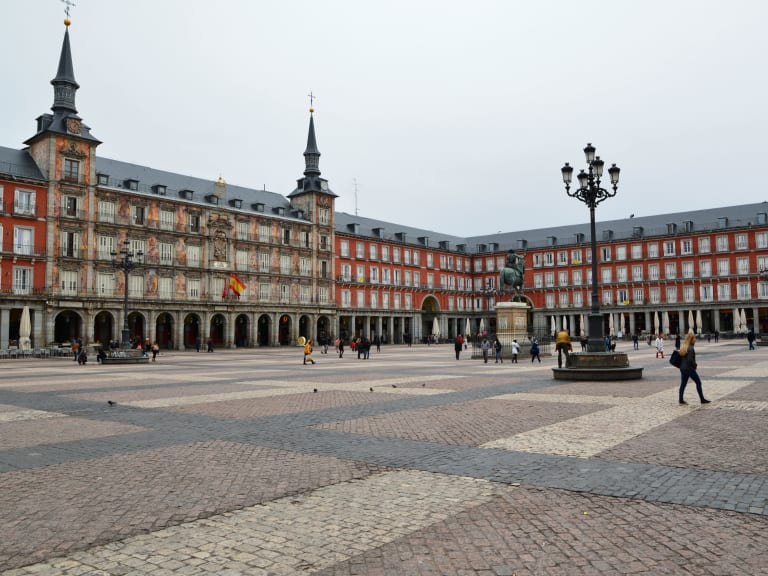
From the passageway of San Ginés, where the chocolate shop of the same name is located, walk to the left through several narrow streets until you reach the Plaza Mayor of Madrid. If you have gone on your own and not with a guided tour, try not to get too lost along the way. You can get there easily if you book the tourist bus around Madrid.
The square was designed by the architects Juan de Herrera and Juan Gómez de la Mora. It is surrounded by arcades and three-storey brick buildings, although many of them have been rebuilt several times after being affected by fires throughout history.
As well as seeing all the arches and strolling through the arcades, which are always full of stalls selling stamps and other items, there are three points not to be missed:
- Statue of Philip II: in 1616, the Duke of Florence gave the King of Spain this statue. For two centuries, it stood in the Casa de Campo and was later moved to the Plaza Mayor.
- Casa de la Panadería: the first building to be constructed in the Plaza Mayor, in 1590, no less.
- Arco de Cuchilleros: the best known of the nine gates that surround the Plaza Mayor.
Grab a bite to eat at one of its most popular markets, such as San Miguel
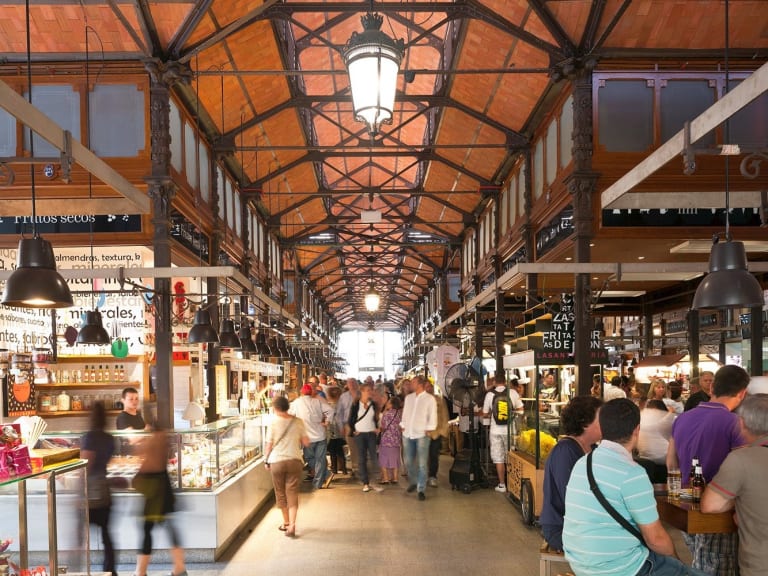
It's quite likely that by now you're already in the mood for a bite to eat. My suggestion is to go to the Mercado de San Miguel, very close to the Plaza Mayor.
In this market you will find a good representation of the best food in the capital and you can book a gastronomic tour. It is housed in a large iron building from the early 20th century.
Becoming the first gastronomic market in the capital in 2009, inside you will find dishes made with products from all over the country, from Galician fish to gourmet cheeses. All of this is spread over more than 30 stalls. Find out more about the wine and tapas tour in Madrid.
Discover the Teatro Real building

Continuing your tour, you will pass in front of the Teatro Real, one of the great centres of opera in Europe. This theatre was inaugurated in 1850, but in 1925 it closed its doors and did not open its doors again until 1966.
After a major refurbishment at the end of the 20th century, the theatre can now seat 1,746 spectators.
The best way to see this theatre is to attend one of the opera performances that take place there. If you can't, you can also take guided tours that include the auditorium, the workshops, the rehearsal rooms and the stage itself. And, to get there, there's nothing better than with your ticket for the Madrid tourist bus
Enter the Royal Palace and its gardens

After seeing the Royal Theatre, the itinerary continues along the nearby Calle Bailén, which is home to several interesting buildings that you will see along the way. This street leads to the Plaza de Oriente, where you will find the next stop of the day: a visit to the Royal Palace, also known as the Palacio de Oriente.
This large building is one of the official residences of the country's kings, although it does not currently function as such. Its size makes it the largest royal palace in Western Europe. My advice is to book a guided tour of the Royal Palace
Although in this article on what to see inside the Royal Palace you will find more in-depth information, in summary its main attractions are as follows:
- Official halls: there are several enormous and very well preserved halls. Of all of them, the throne room stands out.
- Royal Armoury: its collection of weapons, shields and other military objects is among the best in the world.
- Royal Pharmacy: the best place to get an idea of how medicine was practised centuries ago.
- Sabatini Gardens: located in front of the north façade of the Royal Palace.
- Campo del Moro: also close to the building.
Visit the Almudena Cathedral
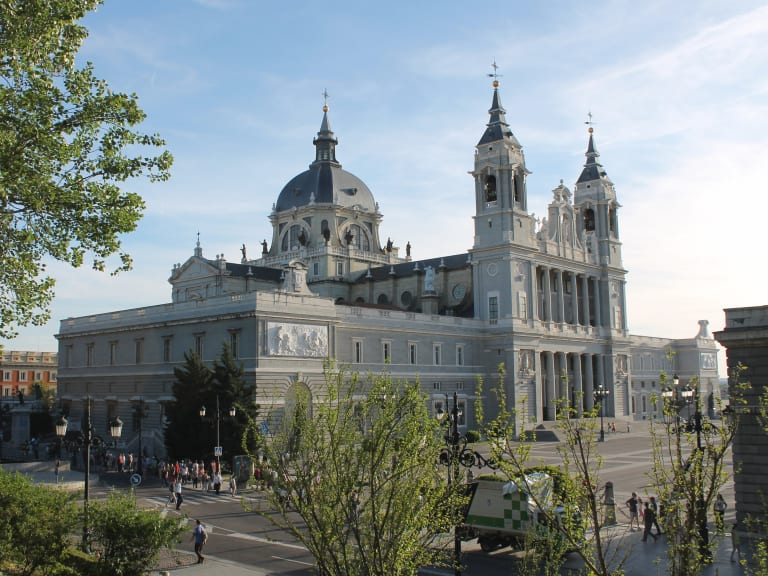
Very close to the Royal Palace is the Almudena Cathedral, the most important church in Madrid. Its construction began in 1879, when Francisco de Cubas presented the first plans for a pantheon for Queen María de las Mercedes.
However, in 1885, with work already begun, it was decided that the project would become the construction of a cathedral. After a few years of standstill, work resumed and the façade was completed in 1960, although it was not until 1993 that Pope John Paul II consecrated the cathedral.
Although the inside of the church is free to enter, the complex houses a museum that tells the history of the diocese and, if you are interested in its history and architecture, I recommend you book a guided tour of the Almudena Cathedral, which also includes the Royal Palace. The dome costs about €6 if you have time to go up, but the views are not particularly interesting.
Enjoy an Egyptian sunset at the Temple of Debod

Walking calmly back along Calle Bailén, you will end up in Plaza de España and, a little further on, in a park where you will find a monument that may seem rather strange: an Egyptian temple.
In case you are wondering, the Temple of Debod is authentic. It is about 2,000 years old and was a gift from Egypt to Spain in 1968 as a thank you for helping to move the Abu Simbel temple when the Aswan Dam was built.
As well as visiting the temple, I recommend you try to get to the site just as it starts to get dark. The views from the lookout point there are great, especially as the sun begins to set. Oh, and if you have booked your ticket for the tourist bus, you should know that one of its stops is precisely the Temple of Debod.
Finish your trip by attending a show in Madrid

Among the plans that Madrid offers its visitors, you can't do without the Madrid nightlife, one of the most vibrant in Spain, so get ready to make it special and end your trip in style.
Besides looking for somewhere to dine, one of the best things you can do is head to the Gran Vía to see some of the fantastic musicals that are usually performed in its theatres. Another option is to book a flamenco show in Madrid, very interesting is to book a flamenco show in Madrid. You have several options:
- Flamenco show at Torres Bermejas in Madrid, from £25.
- Flamenco show at Teatro Flamenco in Madrid, from £57.
- Flamenco show at Corral de la Morería in Madrid, from £50.
- Flamenco show at Essential Madrid, from £35.
And, without a doubt, my favourite option is to book a pub crawl in Madrid to soak up the city's nightlife.




